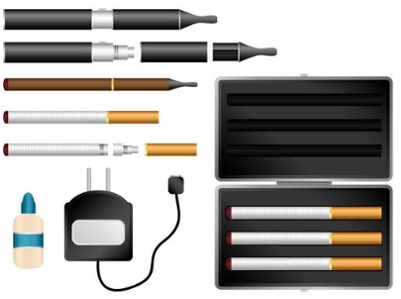Electronic cigarettes - A new form of nicotine use
Electronic cigarettes are emerging as a new form of nicotine delivery and addiction that aligns well with other technological advances of the 21st century. Nicotine-laced propylene glycol, vegetable glycerin, and liquid flavorings are combined to form an e-cigarette juice (e-juice) and heated by a lithium-ion battery producing an aerosol that is inhaled by the user. Research, medical, and public health experts continue to debate and generate evidence on the health effects of inhaling aerosolized e-juice and the cessation potential from combustible tobacco that is typically advertised with these products. TRDRP has sought to fund research that begins to answer critical scientific questions surrounding these products. In this regard, TRDRP researchers were one of the first to show that there are concentrations of metals in e-juices and in the emitted aerosol.
Below, are recent peer-reviewed articles that have resulted from TRDRP-funded research:
Metal and silicate particles including nanoparticles are present in electronic cigarette cartomizer fluid and aerosol.
Williams M, Villarreal A, Bozhilov K, Lin S, Talbot, P. PLoS One, 2013; 8(3).
“The concentrations of nine of eleven elements in electronic cigarette aerosol were higher than or equal to the corresponding concentrations in conventional cigarette smoke. Many of the elements identified in Electronic Cigarette aerosol are known to cause respiratory distress and disease.”
E-Cigarette use among never-smoking California students.
Bostean G, Trinidad DR, McCarthy WJ. 2015. Am J Public Health.
“ . . . the key issue of whether e-cigarette marketing recruits nonsmoking students is clear: under current conditions of minimal federal or state regulation, many middle and high school students who have never used conventional cigarettes or smokeless tobacco use e-cigarettes. “
E-Cigarettes: A scientific review.
Grana R, Benowitz N, Glantz SA. 2014. Circulation.
“To minimize the potential negative impacts on prevention and cessation and the undermining of existing tobacco control measures, e-cigarette use should be prohibited where tobacco cigarette use is prohibited and the products should be subject to the same marketing restrictions as tobacco cigarettes.”
Prevalence and correlates of electronic-cigarette use in young adults: findings from three studies over five years.
Ramo DE, Young-Wolff KC, Prochaska JJ. 2015. Addictive Behaviors.
“Findings from three studies of young adult smokers (two cross-sectional studies and baseline data from a stage-tailored cessation trial) indicate past-month e-cigarette use and ever use of e-cigarettes to quit conventional cigarettes has increased over time."
E-Cigarette use, smoking cessation and change in smoking intensity in the 2010/2011 TUS-CPS longitudinal cohort.
“U.S. smokers who used e-cigarettes as a cessation aid were less successful at quitting than other smokers. The effect of e-cigarette use on smoking intensity was restricted to light smokers who used e-cigarettes for a quit attempt.”
Identification of toxicants in cinnamon-flavored electronic cigarette refill fluids.
Behar RZ, Davis B, Wang Y, Bahl V, Lin S, Talbot P. 2014.Toxicology in Vitro.
Electronic cigarette users have reported that cinnamon-flavored e-juice causes throat, mouth, and lung irritations. This study evaluated the harmfulness of 10 cinnamon-flavored electronic cigarette refill fluids that are also prone to mix with the air. Using human stem cells as model, study found that identified chemicals in e-juices were toxic to embryonic and adult human stem cells. Human embryonic stem cells were generally more sensitive than human adult lung cells. Most products were highly air-sensitive and produced vapors that impaired survival of cells.
Gender differences influence overweight smokers’ experimentation with electronic nicotine delivery systems.
Strong DR, Myers M, Linke S, Leas E, Hofstetter R, Edland S, AlDelaimy WK. 2015. Addictive Behaviors.
Investigators found a large increase in experimentation with electronic nicotine delivery systems (ENDS) from 2011 to 2012. Overweight or obese smokers were more likely to report experimentation with ENDS. Experimentation with ENDS was not associated with a reduction in use of cigarettes or a decrease in cigarette dependence.
Other related California research:
Association of electronic cigarette use with initiation of combustible tobacco product smoking in early adolescence.
“Among high school students in Los Angeles, those who had ever used e-cigarettes at baseline compared with nonusers were more likely to report initiation of combustible tobacco use over the next year.”
NOTE: For more details on the TRDRP-funded E-Cigarettes: Informing tax policy reaserch in California, please click here.

